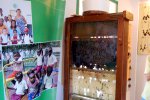After a rough crossing from Chagos to Rodrigues we finally arrived back to civilization. You go alongside the pier in Port Mathurin and the check in is quick and very friendly. You also find out a lot about the island, the big Saturday market and that the nice customs officer likes to sprint and will take part in the 400 m competition in an hour (that's why he was wearing running shoes and outfit...).
The people here are mainly of African origin, 96% are catholic. Compared to Mauritius were over 70% have other religious believes. There is also a Muslim minority, which you notice right away in the way the women dress. Everybody speaks English (the official language), French and Mauritian Creole and is exceptional friendly. The island belongs to Mauritius but is mostly autonomic.
We are impressed by the projects for poor and disadvantaged residents. CARE-CO for example helps people with special needs to get an education in their school and afterward they can choose to learn a handicraft and work at CARE-CO. There they learn how to prepare coconuts which they form into jewelery, cups, toys and many other things. During an interesting and informative visit at CARE-CO you can learn about working with coconut shells and also visit the bee hives, which produce an award-winning honey. In the “Centre de Formacion Agricole Frere Remi” young school drop outs can have a training in organic farming. They learn how to handle animals and how to plant organic wheat, vegetables and fruits. The vegetables and fruits are very thought after and are always sold out quickly. A great project!
The island was discovered in 1528 by Diego Rodrigues – therefor the name. But only in the 17th century people started to live on Rodrigues. At that time there still were about 400.000 and more giant tortoises living on the island. Within 100 years the two endemic species of giant tortoises were wiped out (eaten!), as well as many other special animal species (for example the giant salamander or the solitaire bird).
In the meantime a population of tortoises is again living on the island. In a great project – the Francois Leguat Giant Tortoises and Cave Reserve – Aldabra giant tortoises (Aldabrachelys gigantea) are bred since 2004 and are allowed to roam freely inside a natural canyon. Also more than 186.000 endemic and native plants were planted within the reserve. While walking through the Canyon Tiyel you get the impression how the former island looked like with all the giant tortoises and native trees and shrubs. You are also allowed to touch and pet the sometimes over 100 year old Aldabra giant tortoises under supervision and can feed them leafs. They like to be touched at their neck and stretch their throat as high as possible. Also Radiata tortoises (Astrochelys radiata) and the only native mammal the Rodrigues fruit bat (Pteropus rodericensis) have a place to live in the reserve. In the 1970ies there were only about 70 Rodrigues fruit bats left. Since then the population has grown to over 2000 individuals again.
During the visit of the reserve you also get to see one of a few limestone caves where you can look at imposing stalagmites and stalactites. Finally there is a great small museum where you can learn a lot about the history and the plants and animals of the island – especially the Solitaire bird and the giant tortoises, who were all killed.
To drain the swamps dry a lot of Eucalyptus trees were planted, which in the meantime are very popular with the beekeepers and wood-processing companies. The ability of those plants to drain all the water out of the earth was the reason they were planted – but now nobody knows this anymore. Even though nowadays Rodrigues has immense water problems and suffers from drought in the summer, they are still planting more and more Eucalyptus trees. Possibly they should think to replace the Eucalyptus trees with native trees .
Exploring the island is very easy with the local buses. There are countless and beautiful hiking trails along the coast and inland. The island is also perfect for mountain bike tours and kite surfing, as well as diving. Rodrigues really is a very special place with nice people and far away from mass tourism, so one can really enjoy the time here.











.jpg)
.jpg)
_live.jpg)
_are_much_smaller.jpg)


_in_the_reserve_which_is_called_Romeo.jpg)

_live.jpg)


























 >>planned route - join us ...
>>planned route - join us ...